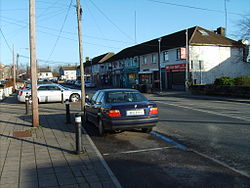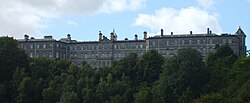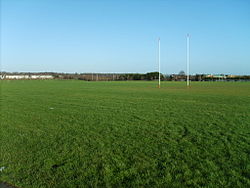Palmerstown
 From Wikipedia - Reading time: 13 min
From Wikipedia - Reading time: 13 min
Palmerstown
Baile Phámar | |
|---|---|
Town | |
 | |
| Coordinates: 53°21′00″N 6°22′44″W / 53.35°N 6.379°W | |
| Country | Ireland |
| Province | Leinster |
| County | South Dublin |
| Dáil Éireann | Dublin Mid-West |
| European Parliament | Dublin |
| Elevation | 17 m (56 ft) |
| Population (2016) | |
| • Urban | 11,130 |
| Time zone | UTC+0 (WET) |
| • Summer (DST) | UTC-1 (IST (WEST)) |
| Irish Grid Reference | O082345 |
| Website | www |
Palmerstown (Irish: Baile Phámar; officially Palmerston, see spelling) is a civil parish and suburb in western Dublin on the banks of the River Liffey. It forms part of the South Dublin local authority and the Dublin Mid-West parliamentary constituency. The area is bordered to the north by the River Liffey and the Strawberry Beds, to the west by Lucan, to the south-west by Clondalkin, to the south by Ballyfermot and to the east by the village of Chapelizod. Palmerstown village is situated near the Liffey Valley Shopping Centre. The area is situated near the major junction of the M50 motorway and the N4. It lies approximately 7 km west of O'Connell Street in Dublin city centre. The Old Lucan Road, once the main route from the city to the west, passes through the centre of Palmerstown village.
Name origin and spelling
[edit]A "palmer" in medieval times was a pilgrim who returned from the Holy Land with a palm branch or leaf.[2] Between 1185 and 1188 Ailred the Palmer and his wife took religious vows and founded a priory and monastic hospital of Crutched Friars outside the West Gate of Dublin, on the road to Kilmainham, which they endowed with all their property.[3] In 1188 Pope Clement III confirmed the priory's grants, including both the parish of Palmerstown west of Kilmainham and the other parish of Palmerstown northwards in Fingal.[3] Gerard Lee notes an association of palmers with leper hospitals, of which there was one dedicated to Saint Laurence in the townland of the Saint Laurence in Palmerstown.[2][4]
The spelling "Palmerston" rather than "Palmerstown" was fixed by the Ordnance Survey of Ireland in the 1830s; this remains the legal spelling and is officially recognised by South Dublin County Council.[5] Locals generally use "Palmerstown", and road signs have used both.[6] A plebiscite of residents is required for a legal name change.[n 1] In 2009 a plebiscite to change to "Palmerstown" received a majority of votes cast but not of eligible voters.[10] The area concerned was the townlands of Palmerston Upper and Palmerston Lower with an estimated electorate of 8,000.[11] Supporters of the change argued that the wording of the ballot confused some voters who wanted "Palmerstown" but voted No.[10] They also argue the spelling without W creates confusion with Palmerston Park further east in Rathmines.[10] Opponents argue the cost of changing road signs is prohibitive.[10] Others argue that the name "Palmerston" legally applies only to the civil parish and townland, and that the locality known as "Palmerstown" has a separate identity.[6] In 2014, another plebiscite was held, restricted to the electoral division (ED) of Palmerston Village (bounded by the Liffey, M50, and N4[12]) and excluding the adjoining ED of Palmerston West.[13] The electorate was 641, of whom 425 voted in favour and 17 against;[14] the change to "Palmerstown Village" was formally approved at the county council meeting in January 2015.[13]
The title Viscount Palmerston created in 1722 in the Peerage of Ireland derives from the place;[15] its spelling also varied,[16] but the form "Lord Palmerston" is now usual for the Victorian prime minister.[17]
Townlands
[edit]The civil parish of Palmerstown is the most northerly parish in the former Barony of Uppercross. Much of Palmerstown has been developed for residential, transportation and commercial purposes over the last half century. Townlands include:[18]
- Palmerston Lower
- Palmerston Upper
- Irishtown
- Saint Laurence
- Johnstown
- Palmerstown Manor
- Yellow Walls
- Fonthill
- Redcowfarm
- Woodfarm
- Quarryvale
- Brooklawn
- Liffey Valley
Palmerstown village
[edit]

The townlands of Palmerstown Upper and Palmerstown Lower straddle the old Lucan Road which was the ancient western highway. Many of Palmerstown's local amenities are located in a cluster along the road. Robin Villas and Hollyville were labourers' cottages built at the beginning of the last century. The old national school is now a community centre. Stewarts Hospital, (formerly the residence of the Hely-Hutchinson family, the Roman Catholic Church of St. Philomena, the National School, the Palmerstown House Pub and Restaurant and a variety of general enterprises, including a bank and convenience stores are located here. Stewartscare is a health care facility at the Stewarts buildings and grounds which overlook the meandering Liffey valley. The Stewarts complex houses the administration of the Irish Health Service Executive. Stewarts Sports and Leisure centre is open to the general public. It also hosts an annual summer camp.
Redcow Farm and Glenaulin Park
[edit]
This area was the location of the first modern housing development in Palmerstown, constructed between 1955 and 1965. Centred on Manor road, this area contains several shops, the local credit union and a doctor's surgery. To the east of Redcow Farm, adjacent to the "California Hills" Park, is Glenaulin Park, a public park also home to St. Patricks GAA club. The park contains a short stretch of a local stream, the Glenaulin Stream, a Liffey tributary most of which runs in culvert.[19]
The name 'California Hills' was given by the children of the area to a small wasteland in Ballyfermot to the northeast of Glenaulin Park, which had been a builders' dump during the construction of the main Palmerstown Estate in the mid to late 1960's. The wasteland had a series of small hills which were in fact mounds of rubble which had been buried under clay and eventually over grown with wild grass. The children of the area sometimes shortened the name to 'The Caliers' and this name is also still in use today. The hills or mounds were flattened some years ago and the area landscaped for communal/public use.
Palmerstown Lower
[edit]Mill Lane leads to the original Palmerstown settlement and centre of industry, which once employed over 600 millhands, craftsmen, and labourers. This seventeenth-century low-lying waterside industrial village was complete with flax, seed, oil, flour and cloth mills.[20] The ruin of a pre-Norman church and the remains of the once prosperous thriving community are situated near the river. A small ferry crossed the Liffey here, to where the Wren's Nest pub was situated on the North side. A football ground opposite the river Liffey is home to Palmerstown F.C. Muhammad Ali visited Stewarts Hospital on 15 July 1972 when the hospital was hosting its annual sporting fete.[21]
Palmerstown Manor
[edit]Palmerstown's largest housing estate was built in the early 1990s in the south east of the area. Adjacent to the Coldcut and Kennelsfort roads and the M50 motorway, the estate marks the 'border' between Palmerstown with Ballyfermot and Clondalkin.
Woodfarm Acres
[edit]The townland of Woodfarm Acres was mostly farmland, with a few council cottages previously existed on the site. This housing development was built during the 1970s. The estate is bounded by the M50 motorway and N4. Adjacent to Woodfarm Acres is another shopping centre containing a local SuperValu market, a gym and other amenities. Access to the local cemetery is adjacent to this centre. The Silver Granite Pub is located nearby, as is Pobalscoil Isolde, a secondary-level community school which opened in the 1980s.
Oakcourt
[edit]The Oakcourt housing estate lies in the western part of the 59-acre Johnstown townland, behind Pobalscoil Iosolde. It was originally developed in the 1970s, and expanded in the mid-1990s. The Johnstown townland extends due west from the Georgian Johnstown House (now St. John's College) on Le Fanu Rd. It runs west to Kennelsfort Road and lies between St. Laurence townland (the St. Laurence House is now the West County Hotel) from the River Liffey and Chapelizod in the north, to Ballyfermot Upper/Blackditch on the south.
Transport
[edit]Palmerstown has some of the finest transport links of any Dublin suburb. The main public transport is Dublin Bus running via the N4 at Palmerstown village. Scheduled services run east to the city and west to Lucan, Celbridge, Leixlip and Maynooth. Route 26 operates from Liffey Valley to Dublin city via Kennelsfort Road Upper and Chapelizod. Route 18, a circular city route runs from the Old Lucan Road to Sandymount Green via many south Dublin suburbs including Walkinstown, Crumlin and Rathgar. Route G2 operates via the Coldcut road to Spencer Dock via Dublin city. Routes C1, C2, C3 and C4 operate via the Chapelizod Bypass to Ringsend or Sandymount via Dublin City. Palmerstown railway station on the Dublin and Lucan tramway, later part of the Dublin United Transport Company tram system, opened in November 1881 and closed on 13 April 1940.[22]
Palmerstown Cemetery
[edit]Palmerstown Cemetery was originally opened in 1978. It is located on Kennelsfort Road, adjacent to Woodfarm Acres. It is currently being managed as part of the Glasnevin Trust.[23]
See also
[edit]Footnote
[edit]- ^ Technically, the plebiscite is of ratepayers, both business and domestic, as required by the Local Government Act 1946 and detailed in a 1956 statutory instrument.[7] Domestic rates have not been levied since 1978 but residents are still legally classed as ratepayers.[8] The relevant provisions of the 1946 act are replaced by Part 18 of the Local Government Act 2001, itself amended in 2011.[9] However, the 1956 provisions were used for the Palmerstown plebiscites held in 2009 and 2014, because Part 18 had not commenced.[9]
References
[edit]- ^ Maps, Weather, and Airports for Palmerston, Ireland
- ^ a b Lee, Gerard A. (June 1967). "Leprosy and certain Irish placenames" (PDF). Dinnseanchas. 2 (3): 71–72. Retrieved 7 November 2014.
- ^ a b Hennessy, Mark (1988). "The priory and hospital of New Gate: the evolution and decline of a medieval monastic estate". In Smyth, William J.; Whelan, Kevin (eds.). Common Ground: Essays on the Historical Geography of Ireland : Presented to T. Jones Hughes. Cork University Press. pp. 41–54 : 42–43.
- ^ "Saintlaurence". Placenames Database of Ireland. Retrieved 7 November 2014.
This place appears to have taken its name from a leprosy hospital dedicated to the martyr Saint Laurence.
- ^ Palmerston - Chronology Archived 2014-10-15 at the Wayback Machine
- ^ a b Palmerston will vote to end a very bad spell
- ^ "Proposed Change Of Name Of A Locality (Palmerston Village To Palmerstown Village)" (PDF). South Dublin County Council. 2014. Retrieved 19 April 2018.
In accordance with Section 79 of the Local Government Act 1946 and the Local Government (Changing of Place Names Regulations) 1956 (as amended by Section 67 of Local Government Act 1994)
; "S.I. No. 31/1956 - Local Government (Changing of Place Names) Regulations, 1956". Irish Statute Book. Retrieved 19 April 2018. - ^ "Local Government (Financial Provisions) Act, 1978, Section 17". Irish Statute Book. Retrieved 19 April 2018.
- ^ a b "Local Government Act 2001". Revised Acts of the Oireachtas. Law Reform Commission. 10 November 2017. Retrieved 19 April 2018.
- ^ a b c d Council faces a €70k bill for second vote in name row over Palmersto(w)n
- ^
- "July 2008 council meeting agenda". South Dublin County Council. H 4 (e) (v) Plebiscite for Palmerston.
- "H 4 (e) (v) Plebiscite for Palmerston - Report". July 2008 council meeting agenda. South Dublin County Council.
- "H 4 (e) (v) Plebiscite for Palmerston - Townland Map" (JPEG). July 2008 council meeting agenda. South Dublin County Council.
- ^ "Plebiscite boundary map" (PDF). South Dublin County Council. 2014. Retrieved 8 January 2018.
- ^ a b Brophy, Daragh (13 January 2015). "Palmerston or Palmerstown? ... Residents have voted on a name change". TheJournal.ie. Retrieved 8 January 2018.
- ^ Begley, Ian (2–7 January 2015). "Letter 'W' returns to Palmerstown". Dublin Gazette. p. 2. Retrieved 19 December 2021.
- ^ "Palmerstown". The Parliamentary Gazetteer of Ireland: Adapted to the New Poor-law, Franchise, Municipal and Ecclesiastical Arrangements, and Compiled with a Special Reference to the Lines of Railroad and Canal Communication, as Existing in 1844–45. Vol. III: N-Z. A. Fullarton and Company. 1846. p. 68. Retrieved 7 November 2014.
- ^ O'Hart, John (1880). Irish pedigrees; or, The origin and stem of the Irish nation. Dublin: Gill. p. 286.
The Temples, viscounts Palmerstown or Palmerston.
- ^ "Palmerston, Henry John Temple, Viscount, 1784-1865". LC Linked Data Service. Library of Congress. Retrieved 7 November 2014.
- ^ Placenames Database of Ireland - Palmerstown townlands
- ^ Rivers and Streams of the Dublin Region : Dublin city, Fingal, South Dublin & Dun Laoghaire-Rathdown. Dublin, Ireland: Rath Eanna Research. 2018. ISBN 978-09566363-8-6. OCLC 1237252174.
- ^ Registry of Deeds, Dublin. Memorial: 24-316-13903. "A Memoriall of a Deed of Mortgage Indented dated the fifteenth day of September One Thousand Seven hundred and Nineteen... Reciting that Joshua Willson of Palmerstown in the County of Dublin, Gent, by lease dated the 28/03/1717 did demise and sett unto John Byrne two stocks of mills for milling of cloath formerly in the possession of William Watson and James Watson and also an appartment in the house adjoyning unto the said Mills with part of a garden and stable formerly sett out and sett to the said William and James Watson, which premisses are scituate in the town of Palmerstown aforesaid and bounded on the river that runs under the lands belonging to the great house of Palmerstown" [1]
- ^ "When Muhammad Ali came to Palmerstown". Come Here To Me!. 9 June 2016. Retrieved 2 December 2016.
- ^ "Palmerstown station" (PDF). Railscot - Irish Railways. Retrieved 22 November 2007.
- ^ http://www.glasnevintrust.ie/funeral-services/palmerstown-cemetery/ Glasnevin Trust
 KSF
KSF